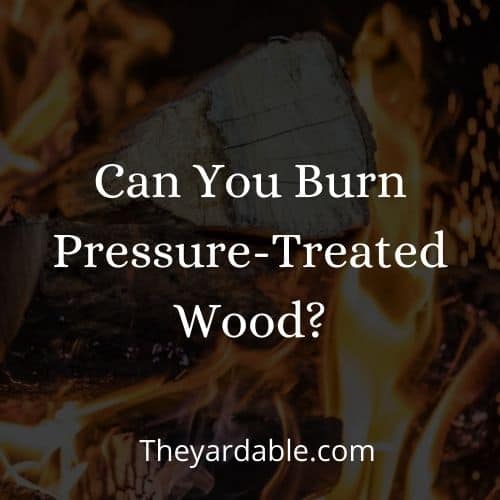A lot of times once you are done with your set of pressure-treated wood, the natural inclination is to just burn it in the fireplace. But maybe you shouldn’t do so. So what should you do with leftover pressure-treated wood? Let’s take a look at everything you need to know about burning it.
Pressure-treated wood should never be burnt in your fireplace. They are treated with dangerous chemicals which can cause both long-term and short-term health damage along with environmental damage.

What Is Pressure Treated Wood?
Before we get started, it is important to know what pressure treated wood actually is. As the name suggests, pressure treated wood is simply treated under pressure and often surrounded by chemicals that are absorbed by the wood.
You will often see half-inch-long splits along with the wood pieces. This is often the place where the pressurized chemicals are injected.
Some of the most commonly used chemicals include alkaline copper quat or ACQ. Copper repels insects and fests or fungi that might grow on wood. This makes the treated wood much more resilient to pests, insects, fungus, rot, water, and fire. But keep in mind that moisture and UV rays can still harm the treated wood.
Can You Burn Pressure Treated Wood?
No! not at all. Burning pressure-treated wood can release a lot of dangerous fumes and particles which can cause long-term health damage along with environmental damage.
On top of this, the US Environmental Protection Agency considers pressure-treated lumber as hazardous waste.
Is Burning Pressure Treated Wood Illegal?
Although not all states have banned burning pressure treated wood specifically most laws have a ban on burning substances that have hazardous smoke and pressure treated wood is usually covered under that.
What Health Effects Will Burning Pressure Treated Wood Have?
When you start burning pressure treated wood, the chemicals within are not burnt off, rather they are released into the atmosphere in gas form and as small particles. Even the ash generated by the burning wood gets settled and spreads dangerous and lethal chemicals.
Most of these chemicals are either fungicides or insecticides so that the wood has protection against them. This is what makes it so dangerous to your health. You can have recurring headaches, joint pain, nosebleeds, hair loss, and fatigue. You can also experience blackouts.
What Are The Environmental Effects Of Burning Pressure Treated Wood?
Not only will there be air pollution because of the particles and fumes released, but there can also be soil and water contamination if too many ash-containing chemicals leach into the ground. This can have devastating effects on the local wildlife and plants.
Is It Okay To Burn Older Treated Wood?
No, not at all. Older treated wood can have even more harmful effects on your health and the environment. This is because earlier, people used to use even more dangerous chemicals like lead, BOCs, etc.
What Should You Do If You Accidentally Burn Pressure Treated Wood?
If you accidentally burn pressure treated wood, you need to immediately ventilate the area and move everyone out of the smoke, try putting out the fire, and let as much air circulate as possible.
The early outsets of contamination can be dizziness, headache, eye pain, and skin irritation. As soon as you notice these symptoms on anyone, take them to the hospital.
How To Get Rid Of Pressure Treated Wood?
The first thing which you should do is to put the treated wood in clearly marked containers so that no one comes near them and accidentally end up burning them. you can also cut the wood into smaller pieces before storing them.
Don’t just throw them in the dumpster as these can contaminate the other garbage which might be reused or recycled but the chemicals won’t dissipate by then. Alternatively, contact your local landfill about disposing of the treated wood.
Conclusion
You should never burn pressure treated as they have been treated with dangerous chemicals which can cause both environmental and long and short-term health damage. These chemicals are released either as tiny particles or fumes.
Recommended reading:

Hi!
I am the guy behind Theyardable.com. I grew up on a homestead and I am here to share the knowledge I have and things I learn while living in the countryside.
